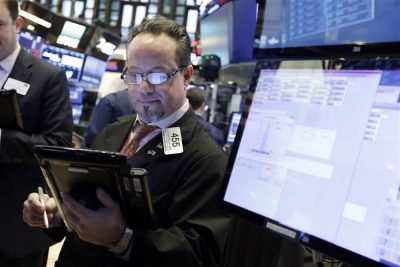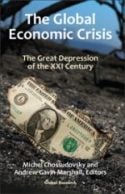Wild Swings on Wall Street at End of Turbulent Week

The US stock market closed up yesterday, with the Dow index rising 330 points in a day of wild swings at the end of the most turbulent week since the 2008 global financial crisis.
In an indication of the market gyrations, the business channel CNBC calculated that the Dow moved a total of 22,000 points up and down during the week, within a 2,000-point range. Movements in prices that would normally take place over hours or days occurred within minutes or even seconds.
Yesterday’s trading was another expression of this volatility. The Dow opened more than 300 points up before falling to 500 points down during the afternoon and then rising again—a swing of over 800 points during the day.
At one point, the more broadly-based S&P 500 index faced an 8.3 percent loss for the week, which would have made it the worst week since November 2008, during the financial crisis. The rally at the end of the day cut its losses for the week to around 5 percent.
The sell-off and wild swings on Wall Street had significant international effects. European stocks on Friday fell for the ninth day out of the last 10 days. The Eurofirst index was down 1.9 percent for the day, taking its losses for the week to 7.2 percent—the biggest fall since the eurozone financial crisis of 2011.
In Asia, Hong Kong’s Hang Seng index closed down 9.5 percent for the week, its worst result in nearly a decade and Japan’s Topix index dropped 7 percent, its biggest weekly fall in almost two years.
In the course of five days an estimated $5.2 trillion was wiped off the value of global equity markets.
The trigger for the sell-off was the return of market volatility last Friday with the announcement of a small increase in US wages—up 2.9 percent for the year. This intersected with an upward movement in the interest rates on the benchmark US 10-year treasury bond to more than 2.8 percent. This was interpreted as sign that the era of ultra-cheap money, created by the quantitative easing policies of the world’s major central banks, could be coming to an end.
The return of volatility to the markets had an immediate impact on Monday when it led to a plunge in so-called exchange-traded products that allowed investors to make bets on the continued low levels of the volatility, or VIX, index. During the course of 2017 the value of these financial products is estimated to have doubled.
Monday’s plunge—when the Dow fell by 1,157 points, its biggest one-day point decline in history—forced two major banks to shut down two such products. Credit Suisse announced on Tuesday it would begin early redemption of a product it had created, once valued at $2.2 billion. The Japanese bank Nomura said it was shutting down a similar product.
The Financial Times noted that the collapse of the two products “and the central role of two significant banks … shone an unwelcome glare on a financial industry that has suffered in the past for its creation of complex financial products that hurt both clients and the economy at large.”
This was a rather understated reference to the creation by the banks and finance industry of a series of complex derivatives that played a major role in precipitating the 2008 meltdown.
As soon as these mechanisms blew up in 2008, however, sparking a financial crisis and the deepest recession since the Great Depression, the banks and finance houses set about creating new ones.
Another Financial Times article this week pointed to the comments of Sandy Rattray, one of those involved in devising a formula to tie contracts to movements in the VIX. He said the index had created a circular system in financial markets, “moving from being a measure of something to being something that influences this thing it is trying to observe.”
Sell-offs caused by a rise in the VIX triggered further sell-offs, generally via computer-generated trading programs. In other words, from being an indicator of risk, the index created more risk for trading models that relied on it.
Rattray claimed he had decided that any model based on the use of the index was too risky to be used.
But others—including some of the world’s major banks and finance houses, such as Barclays, Citigroup, Credit Suisse, UBS and Nomura—piled in, creating a series of products that allowed such bets to be made. The number of contracts in trading products tied to VIX futures and options rose from less than 20,000 in 2009, when such products were first launched, to more than one million by 2016.
While the increasing use of arcane VIX-based products may have been the trigger for the falls, it was not the underlying cause.
The worst week in financial markets since 2008 represents an inflection point—the result of a growing fear that the decade-long inflow of ultra-cheap money, used to finance a whole series of speculative activities, may be over.
This is indicated by the rise in bond market yields that began before the Wall Street sell-off and continued, amid fluctuations, throughout the week.
Since its low point in March 2009, the rise and rise of the stock market has been sustained by the “Fed put”—the belief that the US Federal Reserve would step in and not allow a major fall.
There are limits to that policy, however, determined by fundamental class relations. While it has intervened to support the market, the Fed also stands ready to increase interest rates to counter any significant movement by the working class against the decades-long suppression of wages. That is why the higher-than-expected rise in US wages announced last Friday played such a central role in sparking the market turmoil.
The impact of rising interest rates will go far beyond the financial markets. Since 2008, the limited growth that has taken place in the US, and the global economy more broadly, has been sustained by low rates. In the past decade the overall ratio of global debt to world economic output has increased by some 40 percent.
If interest rates begin to rise, even by a relatively small amount, that will impact heavily on the real economy, hitting a swathe of companies, labelled “zombie firms,” both in the US and Europe that are struggling already to cover their interest payments.
The Global Economic Crisis
The Great Depression of the XXI Century
Global Research
Each of the authors in this timely collection digs beneath the gilded surface to reveal a complex web of deceit and media distortion which serves to conceal the workings of the global economic system and its devastating impacts on people’s lives.
In all major regions of the world, the economic recession is deep-seated, resulting in mass unemployment, the collapse of state social programs and the impoverishment of millions of people. The meltdown of financial markets was the result of  institutionalized fraud and financial manipulation.
institutionalized fraud and financial manipulation.
The economic crisis is accompanied by a worldwide process of militarization, a “war without borders” led by the U.S. and its NATO allies.
Click to order directly from Global Research
This book takes the reader through the corridors of the Federal Reserve, into the plush corporate boardrooms on Wall Street where far-reaching financial transactions are routinely undertaken.
“This important collection offers the reader a most comprehensive analysis of the various facets – especially the financial, social and military ramific ations – from an outstanding list of world-class social thinkers.”
ations – from an outstanding list of world-class social thinkers.”
-Mario Seccareccia, Professor of Economics, University of Ottawa
“In-depth investigations of the inner workings of the plutocracy in crisis, presented by some of our best politico-economic analysts. This book should help put to rest the hallucinations of ‘free market’ ideology.”
-Michael Parenti, author of God and His Demons and Contrary Notions
“Provides a very readable exposé of a global economic system, manipulated by a handful of extremely powerful economic actors for their own benefit, to enrich a few at the expense of an ever-growing majority.”
-David Ray Griffin, author of The New Pearl Harbor Revisited
Click to order directly from Global Research

